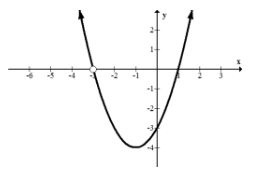2.8 Zeroes of Rational Functions
- Page ID
- 13713
\( \newcommand{\vecs}[1]{\overset { \scriptstyle \rightharpoonup} {\mathbf{#1}} } \)
\( \newcommand{\vecd}[1]{\overset{-\!-\!\rightharpoonup}{\vphantom{a}\smash {#1}}} \)
\( \newcommand{\dsum}{\displaystyle\sum\limits} \)
\( \newcommand{\dint}{\displaystyle\int\limits} \)
\( \newcommand{\dlim}{\displaystyle\lim\limits} \)
\( \newcommand{\id}{\mathrm{id}}\) \( \newcommand{\Span}{\mathrm{span}}\)
( \newcommand{\kernel}{\mathrm{null}\,}\) \( \newcommand{\range}{\mathrm{range}\,}\)
\( \newcommand{\RealPart}{\mathrm{Re}}\) \( \newcommand{\ImaginaryPart}{\mathrm{Im}}\)
\( \newcommand{\Argument}{\mathrm{Arg}}\) \( \newcommand{\norm}[1]{\| #1 \|}\)
\( \newcommand{\inner}[2]{\langle #1, #2 \rangle}\)
\( \newcommand{\Span}{\mathrm{span}}\)
\( \newcommand{\id}{\mathrm{id}}\)
\( \newcommand{\Span}{\mathrm{span}}\)
\( \newcommand{\kernel}{\mathrm{null}\,}\)
\( \newcommand{\range}{\mathrm{range}\,}\)
\( \newcommand{\RealPart}{\mathrm{Re}}\)
\( \newcommand{\ImaginaryPart}{\mathrm{Im}}\)
\( \newcommand{\Argument}{\mathrm{Arg}}\)
\( \newcommand{\norm}[1]{\| #1 \|}\)
\( \newcommand{\inner}[2]{\langle #1, #2 \rangle}\)
\( \newcommand{\Span}{\mathrm{span}}\) \( \newcommand{\AA}{\unicode[.8,0]{x212B}}\)
\( \newcommand{\vectorA}[1]{\vec{#1}} % arrow\)
\( \newcommand{\vectorAt}[1]{\vec{\text{#1}}} % arrow\)
\( \newcommand{\vectorB}[1]{\overset { \scriptstyle \rightharpoonup} {\mathbf{#1}} } \)
\( \newcommand{\vectorC}[1]{\textbf{#1}} \)
\( \newcommand{\vectorD}[1]{\overrightarrow{#1}} \)
\( \newcommand{\vectorDt}[1]{\overrightarrow{\text{#1}}} \)
\( \newcommand{\vectE}[1]{\overset{-\!-\!\rightharpoonup}{\vphantom{a}\smash{\mathbf {#1}}}} \)
\( \newcommand{\vecs}[1]{\overset { \scriptstyle \rightharpoonup} {\mathbf{#1}} } \)
\( \newcommand{\vecd}[1]{\overset{-\!-\!\rightharpoonup}{\vphantom{a}\smash {#1}}} \)
\(\newcommand{\avec}{\mathbf a}\) \(\newcommand{\bvec}{\mathbf b}\) \(\newcommand{\cvec}{\mathbf c}\) \(\newcommand{\dvec}{\mathbf d}\) \(\newcommand{\dtil}{\widetilde{\mathbf d}}\) \(\newcommand{\evec}{\mathbf e}\) \(\newcommand{\fvec}{\mathbf f}\) \(\newcommand{\nvec}{\mathbf n}\) \(\newcommand{\pvec}{\mathbf p}\) \(\newcommand{\qvec}{\mathbf q}\) \(\newcommand{\svec}{\mathbf s}\) \(\newcommand{\tvec}{\mathbf t}\) \(\newcommand{\uvec}{\mathbf u}\) \(\newcommand{\vvec}{\mathbf v}\) \(\newcommand{\wvec}{\mathbf w}\) \(\newcommand{\xvec}{\mathbf x}\) \(\newcommand{\yvec}{\mathbf y}\) \(\newcommand{\zvec}{\mathbf z}\) \(\newcommand{\rvec}{\mathbf r}\) \(\newcommand{\mvec}{\mathbf m}\) \(\newcommand{\zerovec}{\mathbf 0}\) \(\newcommand{\onevec}{\mathbf 1}\) \(\newcommand{\real}{\mathbb R}\) \(\newcommand{\twovec}[2]{\left[\begin{array}{r}#1 \\ #2 \end{array}\right]}\) \(\newcommand{\ctwovec}[2]{\left[\begin{array}{c}#1 \\ #2 \end{array}\right]}\) \(\newcommand{\threevec}[3]{\left[\begin{array}{r}#1 \\ #2 \\ #3 \end{array}\right]}\) \(\newcommand{\cthreevec}[3]{\left[\begin{array}{c}#1 \\ #2 \\ #3 \end{array}\right]}\) \(\newcommand{\fourvec}[4]{\left[\begin{array}{r}#1 \\ #2 \\ #3 \\ #4 \end{array}\right]}\) \(\newcommand{\cfourvec}[4]{\left[\begin{array}{c}#1 \\ #2 \\ #3 \\ #4 \end{array}\right]}\) \(\newcommand{\fivevec}[5]{\left[\begin{array}{r}#1 \\ #2 \\ #3 \\ #4 \\ #5 \\ \end{array}\right]}\) \(\newcommand{\cfivevec}[5]{\left[\begin{array}{c}#1 \\ #2 \\ #3 \\ #4 \\ #5 \\ \end{array}\right]}\) \(\newcommand{\mattwo}[4]{\left[\begin{array}{rr}#1 \amp #2 \\ #3 \amp #4 \\ \end{array}\right]}\) \(\newcommand{\laspan}[1]{\text{Span}\{#1\}}\) \(\newcommand{\bcal}{\cal B}\) \(\newcommand{\ccal}{\cal C}\) \(\newcommand{\scal}{\cal S}\) \(\newcommand{\wcal}{\cal W}\) \(\newcommand{\ecal}{\cal E}\) \(\newcommand{\coords}[2]{\left\{#1\right\}_{#2}}\) \(\newcommand{\gray}[1]{\color{gray}{#1}}\) \(\newcommand{\lgray}[1]{\color{lightgray}{#1}}\) \(\newcommand{\rank}{\operatorname{rank}}\) \(\newcommand{\row}{\text{Row}}\) \(\newcommand{\col}{\text{Col}}\) \(\renewcommand{\row}{\text{Row}}\) \(\newcommand{\nul}{\text{Nul}}\) \(\newcommand{\var}{\text{Var}}\) \(\newcommand{\corr}{\text{corr}}\) \(\newcommand{\len}[1]{\left|#1\right|}\) \(\newcommand{\bbar}{\overline{\bvec}}\) \(\newcommand{\bhat}{\widehat{\bvec}}\) \(\newcommand{\bperp}{\bvec^\perp}\) \(\newcommand{\xhat}{\widehat{\xvec}}\) \(\newcommand{\vhat}{\widehat{\vvec}}\) \(\newcommand{\uhat}{\widehat{\uvec}}\) \(\newcommand{\what}{\widehat{\wvec}}\) \(\newcommand{\Sighat}{\widehat{\Sigma}}\) \(\newcommand{\lt}{<}\) \(\newcommand{\gt}{>}\) \(\newcommand{\amp}{&}\) \(\definecolor{fillinmathshade}{gray}{0.9}\)The zeroes of a function are the collection of \(x\) values where the height of the function is zero. How do you find these values for a rational function and what happens if the zero turns out to be a hole?
Finding Zeroes of Rational Functions
Zeroes are also known as \(x\) -intercepts, solutions or roots of functions. They are the \(x\) values where the height of the function is zero. For rational functions, you need to set the numerator of the function equal to zero and solve for the possible \(x\) values. If a hole occurs on the \(x\) value, then it is not considered a zero because the function is not truly defined at that point.
Take the following rational function:
\(f(x)=\frac{(x-1)(x+3)(x+3)}{x+3}\)
Notice how one of the \(x+3\) factors seems to cancel and indicate a removable discontinuity. Even though there are two \(x+3\) factors, the only zero occurs at \(x=1\) and the hole occurs at (-3,0).

Watch the video below and focus on the portion of this video discussing holes and \(x\) -intercepts.
Examples
Earlier, you were asked how to find the zeroes of a rational function and what happens if the zero is a hole. To find the zeroes of a rational function, set the numerator equal to zero and solve for the \(x\) values. When a hole and a zero occur at the same point, the hole wins and there is no zero at that point.
Create a function with zeroes at \(x=1,2,3\) and holes at \(x=0,4\).
There are an infinite number of possible functions that fit this description because the function can be multiplied by any constant. One possible function could be:
\(f(x)=\frac{(x-1)(x-2)(x-3) x(x-4)}{x(x-4)}\)
Note that 0 and 4 are holes because they cancel out.
Identify the zeroes, holes and \(y\) intercepts of the following rational function without graphing.
\(f(x)=\frac{x(x-2)(x-1)(x+1)(x+1)(x+2)}{(x-1)(x+1)}\)
The holes occur at \(x=-1,1\). To get the exact points, these values must be substituted into the function with the factors canceled.
\(\begin{aligned} f(x) &=x(x-2)(x+1)(x+2) \\ f(-1) &=0, f(1)=-6 \end{aligned}\)
The holes are (-1,0)\(;(1,6)\). The zeroes occur at \(x=0,2,-2\). The zero that is supposed to occur at \(x=-1\) has already been demonstrated to be a hole instead.
Identify the y intercepts, holes, and zeroes of the following rational function.
\(f(x)=\frac{6 x^{3}-7 x^{2}-x+2}{x-1}\)
After noticing that a possible hole occurs at \(x=1\) and using polynomial long division on the numerator you should get:
\(f(x)=\left(6 x^{2}-x-2\right) \cdot \frac{x-1}{x-1}\)
A hole occurs at \(x=1\) which turns out to be the point (1,3) because \(6 \cdot 1^{2}-1-2=3\).
The \(y\) -intercept always occurs where \(x=0\) which turns out to be the point (0,-2) because \(f(0)=-2\)
To find the \(x\) -intercepts you need to factor the remaining part of the function:
\((2 x+1)(3 x-2)\)
Thus the zeroes \(\left(x\right.\) -intercepts) are \(x=-\frac{1}{2}, \frac{2}{3}\).
Identify the zeroes and holes of the following rational function.
\(f(x)=\frac{2(x+1)(x+1)(x+1)}{2(x+1)}\)
The hole occurs at \(x=-1\) which turns out to be a double zero. The hole still wins so the point (-1,0) is a hole. There are no zeroes. The constant 2 in front of the numerator and the denominator serves to illustrate the fact that constant scalars do not impact the \(x\) values of either the zeroes or holes of a function.
Review
Identify the intercepts and holes of each of the following rational functions.
1. \(f(x)=\frac{x^{3}+x^{2}-10 x+8}{x-2}\)
2. \(g(x)=\frac{6 x^{3}-17 x^{2}-5 x+6}{x-3}\)
3. \(h(x)=\frac{(x+2)(1-x)}{x-1}\)
4. \(j(x)=\frac{(x-4)(x+2)(x+2)}{x+2}\)
5. \(k(x)=\frac{x(x-3)(x-4)(x+4)(x+4)(x+2)}{(x-3)(x+4)}\)
6. \(f(x)=\frac{x(x+1)(x+1)(x-1)}{(x-1)(x+1)}\)
7. \(g(x)=\frac{x^{3}-x^{2}-x+1}{x^{2}-1}\)
8. \(h(x)=\frac{4-x^{2}}{x-2}\)
9. Create a function with holes at \(x=3,5,9\) and zeroes at \(x=1,2\).
10. Create a function with holes at \(x=-1,4\) and zeroes at \(x=1\).
11. Create a function with holes at \(x=0,5\) and zeroes at \(x=2,3\).
12. Create a function with holes at \(x=-3,5\) and zeroes at \(x=4\).
13. Create a function with holes at \(x=-2,6\) and zeroes at \(x=0,3\).
14. Create a function with holes at \(x=1,5\) and zeroes at \(x=0,6\).
15. Create a function with holes at \(x=2,7\) and zeroes at \(x=3\).

